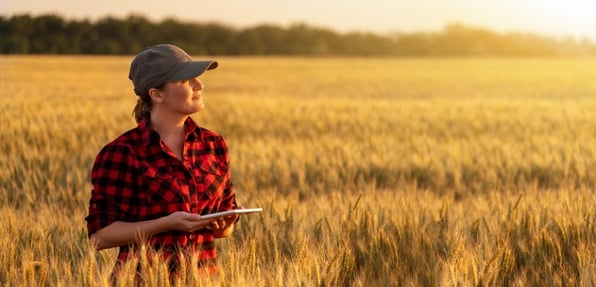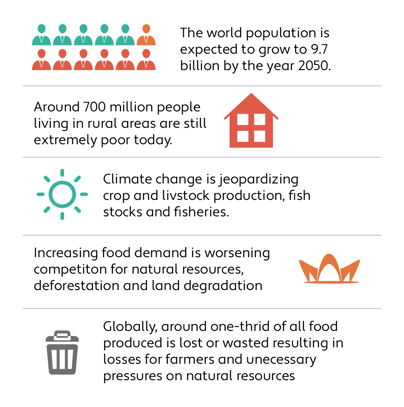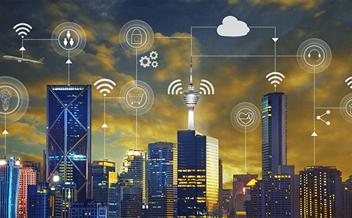

Precision Farming - IoT Applications in Agriculture
The United Nations just held a conference concerning the topic of sustainable farming on September 23rd.
Sustainable farming is a topic that’s been growing in concern and scope for several decades — with more challenges than solutions to date. But could the Internet of Things, or "IoT", present one of the most compelling solutions we’ve seen so far?
IoT combines cutting-edge tech from various sectors, connects them and creates unprecedented opportunities. One route forward is precision farming — which could change the future of agriculture for good.
The current state of agriculture (and its challenges)
Agriculture has never been a straightforward industry, but prevailing global trends have made it even more challenging.
Climate change and reduced biodiversity are two significant factors affecting agriculture, both of which make traditional farming techniques gradually less effective.
Another key obstacle farmers are facing is the demand for higher-quality food. Consumers' tastes and expectations are changing, making it more difficult to satisfy the market with existing farming methods.

Source: <The future of food and agriculture: Trends and challenges>
And as these expectations and environmental changes hit the sector, fewer farmers are able to tackle them. Farmers need to adopt and learn how to incorporate new technology into farms for themselves and inspire the next generation of farmers.
What is precision farming?
Precision farming refers to various methods and tools that farmers can use to improve the efficiency, productivity and timing of their farming. It combines advances in technology and connectivity to optimise crop yield, boost the soil quality, and overcome short- and long-term challenges (including climate change).
By combining these tools and techniques, precision farming becomes just that: a more precise way of farming. Farmers can use precision farming to be more exact, accurate and effective, while also being less dependent on uncontrollable factors, such as the weather.
Precision farming can be divided into two states:
- One where a farmer is collecting data to make better-informed decisions
- And another is where the farmer is turning this data into action to achieve their goals.
How can IoT address the challenges facing modern farmers?
Modern farmers have likely heard talk of "Agriculture 4.0", which might sound like a vague buzzword on the surface.
Behind the catchy name, though, is a practical application of precision agricultural technology. In short, Agriculture 4.0 is the next stage of precision farming. Here, IoT and precision agriculture strategies will converge to create an interconnected network of new farming technologies.
There are several ways that precision farming can solve the challenges of agriculture by using IoT. Farmers can more easily collect data on their farms — allowing them to develop strategies specific to their land and the current year.
Precision farming encompasses cutting-edge agricultural tech such as:
- Automated farm vehicles and equipment.
- Sensors and maps to determine where to dispense fertiliser and how much.
- Remote diagnostics and management of farming vehicles.
IoT Connectivity in farming
For precision farming to achieve its full potential, connectivity technologies need to be brought to the farm. Depending on the needs and purpose for using IoT on the field or farm, the connected farming infrastructure may need to rely on real-time data or span a very large area.
Here is what to consider when looking to optimise your farming:
By its very nature, farming takes place in rural or remote areas. That's why network coverage is a crucial factor in precision farming. Rural areas are traditionally the regions with minimal or unreliable access to cellular connectivity and the last to adopt advancements like 5G. In many cases, Wi-Fi is completely off the table, as it cannot affordably or effectively cover the area of even a small farm, let alone support large data transfers for real-time monitoring or automation.
How FieldWise and Velos IoT keep central pivot irrigating systems connected

Based in Nebraska, FieldWise is a world leader in providing the agriculture market with affordable technology and services in central pivot irrigation. Farms across the world use FieldWise's tech to monitor farms remotely, reduce water consumption, and increase field productivity.
But FieldWise had a challenge: its popularity across the U.S. led to international markets asking for FieldWise's technology. However, deploying IoT precision farming tech outside of its home country, however, wouldn't work with FieldWise's existing networking approach.
That's where Velos IoT was able to help. With truly global connectivity, Velos IoT was able to provide FieldWise with a single-service networking solution, keeping them connected across the world — including in its home state of Nebraska.
Velos IoT is built for drone connectivity

Unmanned drones are one of the most important technologies in precision farming. Drones can be used to provide real-time visibility, monitor the progress of crops, detect threats to a crop, and more while the farmer works from a desk.
Velos IoT provides a sophisticated connectivity option for drone technology. Want to see how we enable drones in the real world, not just on paper? Then read this story of how Velos IoT was able to keep the global leading UTM provider with a connectivity solution.
Get in touch with the team today to see how Velos IoT can help you transform your farm’s efficiency and future-proof your business.
Speak to a Velos IoT expert
Related articles


Top 10 IoT Security Risks and How to avoid them?
Adopting IoT technology can lead to improved performance, efficiency and valuable operational...

How the Internet of Things (IoT) is transforming Smart Cities
The idea of the "Smart City," is something we've been dreaming of since the days of The Jetsons and...